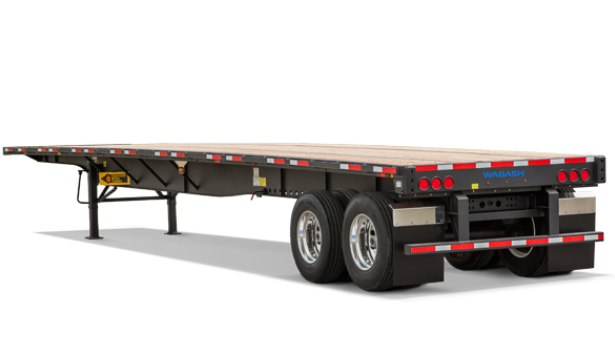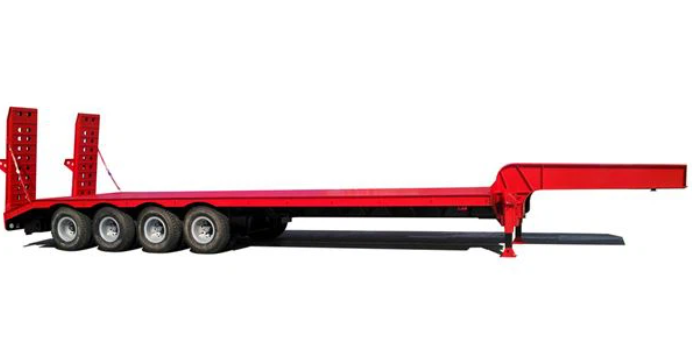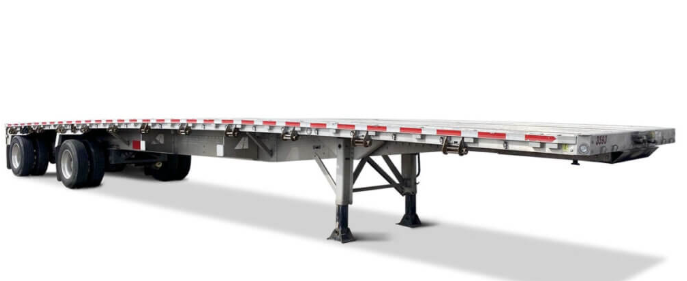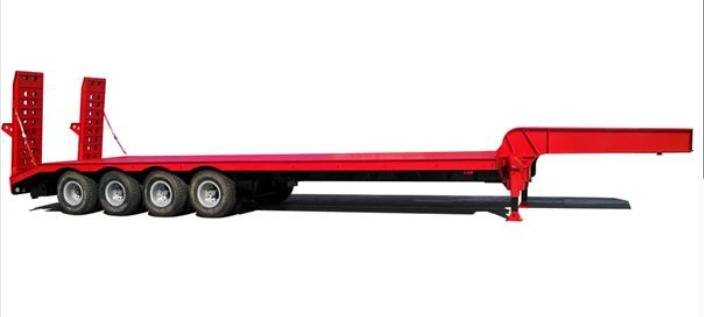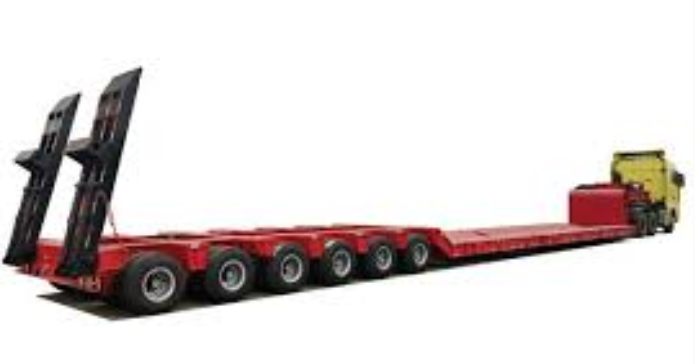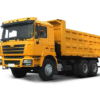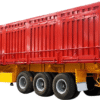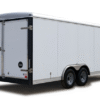After years of hauling everything from steel coils to excavators, I learned the hard way that grabbing the wrong trailer type isn’t just inconvenient – it can cost you the job or worse. The biggest confusion I see? Folks mixing up standard Flatbed trailers and low bed trailers (often called lowboys or lowloaders). At first glance, they both haul big stuff, but trust me, that critical difference in deck height changes absolutely everything about what you can safely move and how you load it.
Picture this: you roll up with a standard flatbed expecting to load a mini-excavator, only to find the machine’s tracks sit taller than the deck itself – that’s a dead-end job right there. That’s where low bed trailers earn their keep. Unlike a flatbed sitting maybe 3 to 5 feet off the ground, a low bed trailer‘s whole design is about hugging the pavement, sometimes getting as low as 18-24 inches thanks to that distinctive gooseneck design and drop axles. This isn’t just a ‘nice-to-have’ lower deck; it’s the only way to legally haul tall equipment like bulldozers, combines, or large construction machinery without smashing into bridges or power lines.
So, how do you pick? Here’s my rule of thumb: If your cargo loads easily with a forklift or crane and fits under standard clearances (think pallets, lumber, machinery under ~10-12 feet tall), a sturdy flatbed is likely your efficient, versatile workhorse. But the moment you’re dealing with massive height, extreme weight concentrated in a small footprint (like a 20-ton rock crusher), or anything that needs to drive on using ramps instead of a crane, that’s when you absolutely need the specialized muscle and ultra-low profile of a low bed trailer. Ignoring this switch is asking for a white-knuckle drive or a costly roadside inspection fail.
Deck Height and Ground Clearance
I find that the differences in deck height and ground clearance between Flatbed Trailers and low bed (lowboy) trailers are quite clear. These differences really determine what type of cargo each trailer can effectively handle.
Deck Height Comparison
- Flatbed trailers, from my experience, often have a deck height around 60 inches (5 feet) above the ground. I’ve also seen some lower-profile models and flatbed deckovers with deck heights closer to 32 inches. You might also see models for specific uses in the 23 to 26 inches (1’11” to 2’2″) range, but I consider 60 inches the main standard.
- Low bed (lowboy) trailers offer a much lower deck height. I generally see these in the range of 20 to 22 inches. I believe this design is key for carrying taller machinery and equipment, as it helps them stay within legal road height limits.
Ground Clearance Insights
- Flatbed trailers have more space between the trailer and the ground because their deck is higher. I think this makes them good for rougher terrain or uneven loading areas. It also lessens the risk of the trailer bottoming out.
- Lowboy trailers offer less ground clearance due to their lowered frame. While this is great for moving tall and heavy loads, I suggest you drive carefully over bumps or uneven ground to prevent the trailer from scraping.
Quick Comparison Table
| Trailer Type | Typical Deck Height | Ground Clearance | Example Uses |
|---|---|---|---|
| Flatbed | 60 inches | Higher | General freight, multiple loading methods |
| Low Profile Flatbed | 32 inches | Moderate | Small equipment, ATVs, easy loading |
| Low Bed (Lowboy) | 20–22 inches | Lower | Tall/heavy machinery, oversized cargo |
Advantages Related to Deck Height and Ground Clearance
- Flatbed trailers: In my opinion, their greater ground clearance makes them well-suited for general cargo and offers flexible loading options. They handle bumpy or uneven roads better and are less prone to scraping the surface.
- Low bed trailers: I’ve observed that a lower deck height allows these trailers to transport taller or oversized machinery and vehicles. This makes them an excellent choice, I think, for construction equipment or any load that goes beyond standard height limits.
I believe choosing the right trailer mainly depends on the deck height and ground clearance your cargo needs. Flatbeds, in my experience, are excellent for accessibility and adapting to standard freight. Lowboys, on the other hand, are what I see as designed for hauling tall, oversized, or heavy loads with security and efficiency.
Load Capacity and Gross Vehicle Weight Rating (GVWR)
If you’re comparing flatbed trailers and low bed (lowboy) trailers, I think it’s important to understand load capacity and Gross Vehicle Weight Rating (GVWR). This understanding helps you pick the right equipment for your cargo.
Load Capacity Breakdown
Flatbed trailers support a load capacity between 20,000 lbs and 60,000 lbs (about 9 to 27 tonnes). This depends on the trailer’s design and number of axles. A standard flatbed weighs 6,000 to 12,000 lbs and can haul up to 48,000 lbs of freight. I find that if you need to move pallets, pipes, or standard building materials, flatbeds offer a good, flexible option.
Low bed trailers are built for very heavy and oversized hauls. I’ve seen many of these in action. A two-axle low bed trailer weighs 15,000 to 18,000 lbs and offers a capacity around 40,000 lbs. But, models with more axles can significantly increase the GVWR. For example, three-axle units can handle 60 tons (120,000 lbs). Some specialized setups can even manage several hundred tons. In my experience, this makes them perfect for heavy machinery, industrial equipment, or large building parts.
Key GVWR Examples
| Trailer Type | Load Capacity | GVWR Examples | Common Uses |
|---|---|---|---|
| Flatbed Trailer | 20,000 – 60,000 lbs | Up to 48,000 lbs (2–4 axles) | Pallets, pipes, standard freight |
| Low Bed Trailer | 40,000 – 120,000+ lbs | 2 axles: 40,000 lbs | Heavy machinery, oversized/overweight cargo |
| 3 axles: 60 tons+ |
Real-use Cases & Evaluations:
For instance, a three-axle low bed trailer can carry up to 60 tons. This capacity is essential, I believe, for moving large construction equipment. – Flatbeds are good for lighter freight that’s spread out; they handle this kind of load well. But, I’ve learned they don’t work for liquids or loose bulk goods because their decks are open.
– In my view, low bed trailers are very important in industries that often deal with very heavy loads or cargo that is too tall for other trailers.
Considerations When Choosing
From my experience, the choice really depends on your cargo’s weight, its size, and the rules you need to follow. I find that flatbeds work well for many standard loads. Low beds are what you need for tasks requiring a high GVWR. This is common in construction and heavy industry. If your job means moving heavy, oversized, or tall freight, I suggest looking at low bed trailers. Their extra axle options and strong design give you the safety and legal compliance required.
Primary Cargo Types and Applications
When I’m picking between a flatbed trailer and a low bed (lowboy) trailer, I always consider a few key things. First, what kind of cargo will it carry? Second, what specific jobs is each trailer good for? Answering these helps me choose the right equipment for any transportation job.
Typical Cargo Carried by Flatbed Trailers
Flatbed trailers, from my perspective, are known for their open deck. This design is great because you can load or unload cargo from any side. Because of this feature, I find them useful in many different industries.
Common Flatbed Trailer Cargo:
– Steel beams, pipes, and other building materials
– Palletized goods, bulk industrial items
– Lumber, timber, and wood products
– Large agricultural machinery and equipment
– Vehicles and automotive components
– Concrete forms, pre-fabricated structures
The industry-standard flatbeds I see most often are 48 to 53 feet long and 8 feet 6 inches wide. Their capacity goes up to 48,000 pounds. In my experience, flatbeds are my first choice for construction sites and manufacturing plants. I also use them for bulk logistics. This is because they can handle a wide variety of freight that doesn’t have strict size limits.
Low Bed Trailer (Lowboy) Cargo Specialization
I recommend using low bed trailers when your cargo’s height or weight is too much for a standard flatbed. Their deck height is usually 18 to 24 inches from the ground. This lower deck lets you haul machinery or equipment that is much taller.
Low Bed Trailer (Lowboy) Typical Loads: – Bulldozers, cranes, excavators, and other construction equipment – Oversized agricultural machinery – Tall industrial machinery or manufacturing units – Vans, specialty vehicles – Heavy, indivisible loads needing a low center of gravity
Based on my work, I’ve seen that lowboys are vital in heavy construction and for equipment rental companies. They are also key for specialized haulage. These are all areas where you must legally and safely move oversized and overweight machinery.
Application Differences in Real Use
- I think flatbed trailers are perfect for general freight and building supplies. They also work well for any cargo not limited by its height. Their flexible setup allows for quick loading. I’ve noticed this makes deliveries efficient for construction, agriculture, and general logistics tasks.
- I use low bed trailers when following road height limits is a must for tall or heavy cargo. The lowered deck means you can legally transport machinery. This type of machinery would often be too tall to move on public roads otherwise.
Key Takeaway
For me, picking between flatbed and low bed trailers always comes down to a few things: the cargo’s dimensions, its total weight, and any special needs. These needs might include height limits or ground stability concerns. I find flatbeds give you great flexibility and access for both standard and oversized freight. However, if you need to move the tallest and heaviest equipment safely and legally, I’d say lowboys are the only way to go.
Overall Dimensions and Configuration (Length, Width)
Let’s look at flatbed trailers and low bed (lowboy) trailers. I find their overall size and deck design really determine the type of freight they can carry. These dimensions also impact how they comply with transportation laws.
Flatbed Trailer Dimensions
Standard flatbed trailers are often 48 to 53 feet long. Their width is 8.5 feet (102 inches). I’ve noticed this width is the most you can have in many states. You’d need special permits to go wider.For smaller tasks, I see car hauler flatbeds that are 16 to 24 feet long. ATV/UTV trailers are shorter, around 12 to 14 feet. These smaller trailers often have widths from 6 feet up to 8.5 feet.The standard deck (bed) height is around 5 feet (60 inches).The maximum legal cargo width is the same as the trailer’s width, 8.5 feet. I also find the common maximum cargo height is 8.5 feet, due to the bed’s height.You can get Extendable (stretch) flatbeds for special loads. These can be up to 80 feet in length. They keep the standard width and bed height.
Low Bed (Lowboy) Trailer Dimensions
Low bed trailers are quite a bit shorter. They are often 24 to 29 feet long. However, they keep the same 8.5-foot width as flatbeds.What really sets them apart, in my opinion, is their deck (well) height. It’s between 18 and 24 inches. This means you can transport much taller loads than with flatbeds.Because of this lower deck, the maximum legal cargo height goes up to 12 feet. I believe this makes these trailers perfect for hauling things like construction equipment or heavy machinery. They are great for items that would be too tall for a standard flatbed.
Specialized Trailer Configurations
- Step deck trailers (also called drop decks) are a sort of middle ground between flatbeds and lowboys, from my perspective. They are 48–53 feet long and 8.5 feet wide. Their upper deck is often 5 feet high, similar to a standard flatbed. The lower deck, though, drops to about 3.6 feet high. With this design, you can legally haul loads up to 10 feet tall.
Key Points for Selection
Flatbed trailers: I recommend these if you need a long standard length. They are great for general freight, building materials, and items that stay within legal height and width limits.Low bed trailers: These are essential, in my view, for moving tall, heavy, or oversized loads while staying legal. Their total deck length is shorter, but that low deck is key.Step decks and extendable flatbeds: I find these offer flexible choices for cargo that’s longer or taller. They fill the gap for dimensional needs between standard flatbeds and lowboys.
So, to sum it up, if you’re looking for more length and flexibility for general freight, I’d suggest flatbeds. If your job involves moving tall or heavy machinery and you need to stay within highway legal limits, low bed trailers are built just for that. They handle these tasks well with their shorter length but much lower deck height.
Loading and Unloading Mechanisms
When you’re choosing between flatbed trailers and low bed (lowboy) trailers, I find that the loading and unloading methods are a major deciding point. These methods affect safety, speed, and what kinds of cargo each trailer can carry.
Flatbed Trailer Loading and Unloading Methods
Flatbed trailers have an open deck. I think this makes them very flexible for various loading and unloading options:
Side Loading and Unloading: You can use forklifts or cranes to access cargo from either side of the trailer. I find this is the quickest and most common way. It helps you load oversized or odd-shaped freight like steel beams or lumber fast. Since flatbeds don’t often use traditional shipping docks, I believe side access is very important for jobsite flexibility.Rear Loading: Rear loading is possible, though I notice it’s not done as often. If you use this method, I suggest loading heavier items first. You should start at the back to keep the trailer stable.Drop and Hook Operations: I recommend this process. It allows drivers to unhook loaded or empty trailers and connect to another one. This cuts down wait times considerably and makes the fleet more efficient.Use of Safety Ladders: For safety, I always tell operators to use ladders or built-in steps. This helps them get on the tall deck and lowers the risk of falls.Ground Requirements: Based on my experience, you must load and unload on flat, stable ground. This stops loads from shifting or tipping. A slope makes things riskier, more so with heavy or irregular-shaped freight.Workspace Clearance: I always stress that having enough space around the trailer is vital. This is particularly true when you need room for forklifts or cranes to move.https://www.youtube.com/watch?v=YVCX6ZT2f-Y
Real-World Example
Here’s a practical example I can share. You can load a 10,000 lbs wooden crate onto a flatbed from the side using a forklift. For typical palletized loads, I’ve seen that flatbeds often let you finish loading in 15–30 minutes. This really helps speed up work in busy shipping areas.
Low Bed (Lowboy) Trailer Loading and Unloading Mechanisms
In my view, low bed trailers are designed for moving tall or ultra-heavy equipment, such as construction machinery:
- Rear Ramps or Hydraulic Ramps: I find these ramps allow wheeled or tracked equipment (like excavators, bulldozers, or cranes) to drive or be winched onto the deck. This is key for machines that forklifts or cranes can’t manage.
- Hydraulic Lowering Systems: I’ve seen some models that can lower the whole deck even more. This creates a gentle angle for very heavy or high-clearance loads. I believe this feature makes loading items like 50,000 lb bulldozers easier and safer.
- Specialized Securing Mechanisms: I always look for these. You’ll find reinforced decks and dedicated tie-down points. Manufacturers build these to handle high weight concentrations. This also means your cargo stays well-fastened during transport.
Practical Considerations
Loading/Unloading Time: In my experience, moving heavy machinery onto a low bed can take 1–2 hours, sometimes longer. You need to line things up perfectly and tie them down very well.Safety: I always emphasize that working around ramps or hydraulic systems means you need strict safety rules. This helps prevent pinch and crush injuries.
Here’s a good example I can share: You would drive a 50,000 lb bulldozer up the low bed’s hydraulic ramp. You can’t lift it with standard warehouse tools.
My View on Key Differences
From my perspective, flatbed trailers are quick and flexible. They have side loading and easy access. I recommend them for general freight, building materials, and palletized goods.I believe low bed trailers are your best bet for oversized, overheight, and heavy equipment. They come with rear hydraulic ramps and special loading systems. This helps you manage tough jobs and follow all regulations.I think these working details are very important. You need to consider them to pick the best trailer for your cargo, your safety rules, and your project deadlines.
Legal Rules and Permit Needs
I think it’s important to understand the legal rules and permit needs. This helps you choose between a flatbed trailer and a low bed (lowboy) trailer. The rules you follow change based on the trailer type, cargo size, and your planned routes.
Maximum Legal Sizes for Flatbed and Low Bed Trailers
Flatbed Trailers:
- In my experience, the legal deck height is about 5 feet (1.52 meters).
- The highest your cargo can be, including the loaded freight, reaches up to 8.5 feet (2.59 meters) in most places. I’ve found this to be a common limit.
- The maximum cargo width is 8.5 feet (2.59 meters).
- The standard legal length can reach 53 feet (16.15 meters).
Low Bed Trailers:
- The main deck height is much lower, often 1.5 to 2.5 feet (0.5–0.75 meters).
- I’ve seen this lower deck let you carry cargo as tall as 12 feet (3.66 meters) or even more. This capability depends on specific state or country rules.
- I find that width and length limits are often like flatbeds. However, the height advantage is very important for oversized machinery, in my opinion.
Getting Permits for Big and Heavy Loads
Flatbed Trailers:
- I’ve noticed that most standard freight fits within the usual size and weight rules.
- I suggest you check if permits are needed. You’ll need them if the load goes over legal limits for height, width, weight, or length.
- For instance, I’ve found you often don’t need special permits for hauling legal-size lumber or steel beams. This is because they fit standard dimensions.
Low Bed (Lowboy) Trailers:
- I know lowboys are made to carry big cargo. This includes items like construction equipment and tall machinery.
- From my experience, these loads nearly always need special oversize or overweight permits from transport authorities. You must get these before you can drive.
- For example, if I’m moving a bulldozer over 12 feet high or 10 feet wide, I know it will need several permits. I also need to get the route approved. This process can take some time.
State, Provincial, and Federal Rules
I’ve seen rules change by country, state, or province. Most places enforce limits on axle weights and total vehicle weight. For standard US commercial loads, this is often up to 80,000 lbs/36,287 kg. They also have strict size rules I always pay attention to.
Low bed trailers:
- I find they have more travel rules. These can include no travel at night or on weekends, set operating hours, and sometimes police escorts for the biggest cargo.
- I recommend you consider if you need escort (“pilot”) vehicles. You might also need route surveys to avoid low bridges, sharp turns, or roads with weight limits. I think this is a critical step for safety.
- I’ve noticed permit fees are higher for big, heavy loads. Processing can also take more time, particularly for very large items that stretch dimensions.
Some Examples I’ve Seen
- Standard Flatbed Cargo: I observe that for standard flatbed cargo, like steel pipes or lumber, if it stays within 8.5 ft in height/width and under the weight limit, it often travels without needing extra permits.
- Oversize Low Bed Load: For an oversize low bed load, I know if I’m hauling a large excavator that’s 12 feet tall and 10 feet wide, I must get oversize/overweight permits. I also need to get the route pre-approved and hire one or more escort vehicles for the journey. This is a common scenario I’ve encountered.
My Summary of Rule Differences
| Feature | Flatbed Trailer | Low Bed (Lowboy) Trailer |
|---|---|---|
| Legal Height | 8.5 ft (2.59 m) | Up to 12 ft (3.66 m) or more (I see this depends on trailer/region) |
| Permit Needs | Permits for oversize/overweight | Permits almost always needed—I consider oversize/overweight standard for these trailers |
| Common Limits | Standard road weight/dimensions are what I check | I see more checks here. Route, escort, and travel time rules are common requirements. |
| Regulatory Steps | I find the process simple if it’s within standards. | I believe it’s more involved. You have permits, routing, higher fees, and travel limits to consider. |
My Key Points
In my view, flatbed trailers handle most general freight. You often don’t need special permits if you stay within standard legal limits.I know low bed trailers are made for loads that go over these limits. These almost always need careful rule-following, permits, and more planning for operations. I’ve learned this through experience.I’ve seen permit costs, approval times, and safety steps go up a lot for bigger or heavier loads. This is particularly true for low beds, in my observation.
Based on my experience, I always recommend you check your cargo dimensions and route ahead of time. This helps you avoid last-minute problems and extra costs when you use flatbed or low bed trailers.
Structural Design and Axle Configuration
I find that the main structural and axle differences between flatbed and low bed trailers strongly influence what each trailer can transport. This affects how they carry loads with safety and good performance. Let’s explore what makes these two trailer types distinct in their build and axle configuration:
Flatbed Trailer Structural Design
Materials & Build: I’ve observed that flatbed trailers are commonly made from high-tensile steel. For the main beams, Grade 130 KSI steel is often used for flanges. Grade 80 KSI steel is applied to high-stress spots. Grade 50 steel is used for less critical areas.Deck Construction: In my experience, standard flatbeds feature an open deck. This deck gets support from crossmembers, which are often 4-inch steel beams placed 16 inches apart. Formed steel channel main beams provide extra stability. Stake pockets, found every 48 inches, assist in securing loads.Chassis Weight: I suggest considering an upgrade to high-strength steel (HSS), such as in I-beams. This can cut down the trailer’s weight by up to 1,500 kg, and the trailer will still keep its structural strength. This change can also lead to manufacturing cost savings of up to 30%.Standard Dimensions: I note that lengths typically vary from 48 to 53 feet. The width is 8.5 feet, and the bed height is around 5 feet.
Flatbed Axle Configuration
- Axle Setups: I see that tandem axles (two) are the most frequent choice. However, for heavier freight, you can find tridem (three) and quad-axle options.
- Integrated Suspension: I’ve noticed many modern flatbeds incorporate the Hendrickson INTRAAX unit. This unit combines the suspension and axle. The benefit, in my view, is improved durability and smoother handling for the trailer.
Low Bed (Lowboy) Trailer Structural Design
- Frame Design: Low bed trailers, from what I’ve seen, have deep, drop-frame I-beams. The cargo well, where you place the load, sits just 18 to 24 inches off the ground. I believe this design is excellent for carrying taller and heavier equipment.
- Structural Rigidity: I understand that lowboys utilize modular, high-strength steel chassis. You will often see closed cross-member sections. These are made to significantly boost resistance to twisting. For even more strength, some designs use double cross-ties or completely closed cross-members.
- Deck Characteristics: I find their strong frame and lowered deck allow for a legal cargo height of up to 12 feet. This makes them a good choice, in my opinion, for moving construction machinery and oversized items.
Low Bed Trailer Axle Configuration
- Flexible Axle Options: In my experience, low beds frequently come with two to five axles. They might also use spread axles or hydraulic steering. I recommend these features for better stability and easier handling when you have very heavy or unusual loads.
- Engineering Benefits: I’ve seen engineering studies confirm something important: closed cross-member profiles improve the frame’s ability to resist twisting. This means, for me, safer operations when hauling heavy loads.
Quick Facts Table: Structural & Axle Features
| Trailer Type | Main Beam/Frame | Deck Height | Axle Configuration | Key Features |
|---|---|---|---|---|
| Flatbed | Open formed steel channels | 5 feet | Tandem/tridem/quad | 48″ stake pockets, open deck, up to 1,500 kg lighter |
| Low Bed (Lowboy) | Deep, drop-frame I-beams | 18–24 in | 2–5 axles, spread/steer | Closed cross-members, legal cargo height up to 12 feet |
Example from Practice
From my experience, a standard flatbed with tandem axles and a 5-foot deck height can move palletized loads or equipment up to 8.5 feet tall without trouble. Now, if you ask me to move a 60,000-pound excavator that is 12 feet tall, I would tell you that a low bed trailer with a three-axle, low-height design is necessary. This keeps the load within legal height. In this scenario, flatbeds just are not suitable.
Evaluation
Based on my experience, the open, higher structure and tandem axles of flatbeds make them ideal for general freight and for quick loading. I believe low beds are the right choice if you are handling tall, heavy, or awkward machines. Their closed cross-member structures, drop-frame I-beams, and flexible multi-axle setups are key for such tasks.
Key Takeaway:
So, here’s what I think: Flatbeds are great for standard freight that fits within height limits. Low bed trailers, on the other hand, give you the strength and design for oversized, overweight, and very tall cargo. I suggest that choosing between them begins with a good understanding of these basic engineering and axle differences.
summary
I’ve spent years on the road. During this time, I learned something important. Choosing the right trailer is much more than just hauling cargo. I believe it’s about making your business grow and keeping it secure. For instance, sometimes you might need a flatbed. I find them great because they are easy to access from all sides. Other times, you might need a lowboy for its specific strength to carry very heavy equipment. From my experience, understanding these key differences has saved me a lot of trouble. It also helped me protect my professional reputation. So, I always recommend taking your time. You really need to match your trailer to the specific load you’re carrying. In this industry, I’ve found that the details are incredibly important. These details are what make a true professional stand out from someone less experienced.
FAQs
-
Q: “Aren’t low beds just flatbeds with a drop axle? Why not save money and use a flatbed for everything?”
A: I used to think that too – until I got hired to move a 14-foot-tall bulldozer. A standard flatbed sits 3–4 feet off the ground; a true low bed (like a lowboy) drops as low as 18 inches using a gooseneck, telescoping neck (stinger), or jeep dolly. That 2-foot difference is the gap between clearing an overpass and smashing into it. Flatbeds are versatile; low beds exist solely to cheat height restrictions. -
Q: “When do I absolutely NEED a low bed trailer?”
A: The second your load exceeds 12 feet tall or weighs over 40 tons, call a low bed. I’ve hauled crushers, wind turbine blades, and mining rigs – if it’s tall, massively heavy, or requires ramp-loading (like a tracked excavator driving on), only a low bed’s deck strength and ground-hugging design can handle it legally. Trying this on a flatbed risks bending the deck or flipping. -
Q: “Can’t I just use a ‘step-deck’ trailer instead of a low bed? They’re lower than flatbeds.”
A: Step-decks (or drop decks) are great for shorter tall loads (up to 10 feet), but they’re not low beds. A step-deck has a fixed 18–24″ upper deck and a lowered rear section – still higher than a true low boy’s entire 18-inch deck. For context: I fit a 13-foot-tall CNC machine on a step-deck but needed a low bed for a 15-foot combine header. Know your exact height! -
Q: “Why do low beds look so complicated with extra axles and detachable parts?”
A: That complexity is the point. Extra axles (up to 8–9!) distribute insane weight (ever hauled a 50-ton transformer?). Detachable goosenecks or jeep dollies let the deck sit inches off the pavement during loading. Yes, it takes me 15 extra minutes to assemble, but that’s why low beds haul 200% more weight than most flatbeds while staying street-legal. -
Q: “What’s the biggest mistake you see people make choosing between these trailers?”
A: Underestimating total height. I watched a crew try loading a 13-foot excavator onto a flatbed. The tracks cleared, but the cab hit the trailer’s headache rack. Always measure from the ground to the highest point of your load. If it’s over 12 feet, a flatbed won’t cut it. Low beds exist because bridges don’t bend.

